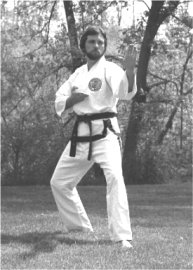

























|

|
|
Tae Kwon Do Patterns
What Are Hyungs? |
|
One of the most important aspects of Tae Kwon Do training is hyungs (patterns). Hyungs, sometimes called tul or poom-se, are a series of offensive and defensive movements arranged in a predetermined pattern and practiced by the student against imaginary opponents. There are many requirements for advancing in rank in Tae Kwon Do, but how well a student performs his hyungs may determine if he will pass or fail.
Hyungs stress the development of correct basics. Each block, strike, and stance must be without flaw. If correct execution of a technique in a hyung is overlooked, then the student will be off balance, thus greatly reducing the amount of power he can generate. The technique would be, to a great extent, ineffective due to lack of power and focus. Since advanced combinations consist of basic (ki bon pronounced "kee bon") movements, the practitioner must have solid basics. Basic patterns (ki bon hyungs) consist of a few blocks and strikes combined with little in the way of footwork. This early integration of basic techniques helps the student develop rhythm, power, and control. As the student progresses through the ranks, the hyungs become increasingly complex. Footwork and body movement intensify until movement becomes more natural and the student's techniques become fluid. It is the coordinated effort of the mind and body, internal and external powers, and reaching for perfection which make hyungs an integral part of Tae Kwon Do.
The foundation of a martial arts style can be seen in its hyungs (patterns). The patterns are the roots of the art as they contain the basics which all who study the art must learn.
To truly understand and begin to learn Tae Kwon Do a student must always strive to perfect the patterns of Tae Kwon Do and follow the philosophy of the art.
|
|
Grand Master Benko's Official International TaeKwon-Do Association Books and DVDs. ITA Home Page Pattern Menu
All rights reserved. |
 While some hyung movements are designed to develop external strength
and power, other hyungs were created to help cultivate internal
strength "Ki" (pronounced Kee). External strength is developed through
proper tensing and relaxing of the muscles, dynamic and rigorous body
movement, and by maintaining correct posture and form.
Internal strength is amplified within hyungs by means of correct
breathing, centralization of power, and by way of intense concentration
with a calm mind. But this is not all hyungs have to offer.
They combine the internal and external forces to stimulate the timing,
speed, and ability of the student to apply the techniques within the hyungs.
While some hyung movements are designed to develop external strength
and power, other hyungs were created to help cultivate internal
strength "Ki" (pronounced Kee). External strength is developed through
proper tensing and relaxing of the muscles, dynamic and rigorous body
movement, and by maintaining correct posture and form.
Internal strength is amplified within hyungs by means of correct
breathing, centralization of power, and by way of intense concentration
with a calm mind. But this is not all hyungs have to offer.
They combine the internal and external forces to stimulate the timing,
speed, and ability of the student to apply the techniques within the hyungs.